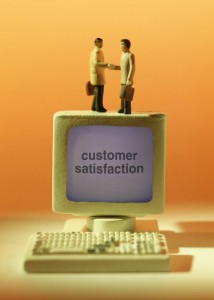 “Do what you do so well that your friends will want to see it again and bring their friends.” -Walt Disney
“Do what you do so well that your friends will want to see it again and bring their friends.” -Walt Disney
This is the last in a three-part series on supply chain recommendations for the new year. To recap, I started this series by reviewing the ‘best of the best’ trend predictions from the last 5 years, and then making recommendations for supply chain modifications to match those trends. I looked at output from 4 different groups: Gartner Analysts, IDC, Ferrari Group, and SupplyChainBrain. I saw prediction patterns emerging that led to my own recommendations for the year ahead.
The first two blogs in the series presented profitable proximity and risk management, both trending supply chain topic predictions for the coming year. As promised in the last blog, though, I feel that this third and final topic for the supply chain is the ‘best’, or what I feel offers the most promise for your investment: customer focus.
Prediction #3: Supply chain customer focus will continue as a strategic priority.

Customers have been in the forefront of supply chain predictions for the last 4 or more years:
- 2009 IDC Prediction #6: Customer Relationship Management (CRM) and consumer-centricity efforts continue to grow across the modern supply chain as manufacturers attempt to improve innovation efforts. The sale is just the start as services become an increasingly important part of the ‘product experience’.
- 2013 IDC Prediction #3 – On the demand side of the supply chain, recognizing the need for better service levels and mass customization, manufacturers look again to postponement techniques and data analytics to drive more effective customer insights and ‘smarter’ fulfillment.
- 2013 IDC Prediction #5 – Service excellence becomes a strategic priority.
Leading consultants like Forrester have defined the “Age of the Customer” as a 20-year cycle wherein CIOs and CMOs will reinvent themselves to win in this age. Forrester points to a transition from focus on manufacturing, to distribution, to information management, to lead up to today’s more towering power of the customer. They say that the leaders in use of technology within this customer obsession hold the key to winning that customer race.
This seems obvious, doesn’t it? But the technology push to deliver a smarter, more innovative product, at a quicker pace, for less cost, and with more satisfaction, is accelerating. Customers expect it, and pay back with their loyalty, and the company stock prices reflect it time and time again. Think about companies like Starbucks, Amazon, and Apple: all at the top of their game, with soaring customer ratings. Amazon has mastered the customer relationship model with customized suggestions based on your purchases. Starbucks is well-loved because of the customer experience as much as the product. Apple, with innovations and scheduled announcements of new products to meet continual customer demand for a product more powerful than the last, came in at the top of the PC ratings for the 10th year running, and in 2012 took over as the world’s most valuable company, with a 4% piece of the S&P 500 pie.

So with those companies on the pinnacle, they stay ahead if they prioritize supply chain customer focus. Mostly, it’s about competition: besides being more cost-effective, those companies know that they simply have to have the best customer satisfaction.
- Customers increasingly want their orders faster. This allows the companies who offer rapid delivery to force out those who don’t keep finished goods inventories. In this environment, good demand forecasting is a must for companies to level out production quantities, build the most competitive transportation and warehousing structures, compete the best supplier contracts, and maintain the most efficient operations.
- Internal organization can improve customer experience. Collaboration is being encouraged within companies to give the customer the experience from purchase through customer service. Our best relationship with one of our most recent vendors underwent seamless transitions from sales to implementation to customer advocates: we’re hooked!
- External factors give breadth beyond historical and seasonal forecasts. Traditional forecasting methods were based on historical and seasonal data, and do not reflect the impact of the economic market’s volatility and resulting customer shifts. For example, consumer attitude, even after financial situations are taken into account, is a leading indicator to durable goods spending every year. Tracking of indices like fuel costs, unemployment rates, and weather patterns are more examples of leading indicators to consumer demand. One of our customers, a manufacturer of snow-clearing products, faced a winter drought that severely decreased demand for their product. That year they admitted that this volatility wreaked havoc on their profits! Their reliance on external indicators of weather patterns, as fed into our forecasting platform, is now allowing them to predict and adjust their manufacturing and inventory levels to those conditions in real-time, drastically reducing required inventory, and leveling out production and logistics costs.
- Providing the latest and greatest products can draw customer loyalty. Customers depend on innovation, and will offer their loyalty to those with the newest, biggest ideas. But studies show that more R&D spending does not equate to more revenue. Only a small percentage of product ideas make it to launch. Less money is lost on a ‘kill’ of a product release pre-launch than a ‘fail’ post-launch! Demand forecasting plays a large part in segmenting what products are worthy of adding to the supply chain. Also, even improvements to old products can alter demand, so demand needs to be analyzed BEFORE any resulting disruptions in production, finance, and logistics are made.
- The closer you are to the customer, the better your service. Sales and marketing research keeps a hand on the customer behavior dynamics through reward-based questionnaires, online forums, blogs, and interviews, and retargeting. Direct feed of information through technology by way of Point-of-Sale or Point-of-Use gives priceless real-time feedback. Evolving from this is the cycle of sensing consumer behavior, measuring marketing effectiveness, adjusting the marketing for optimal impact, all leading to demand-driven forecasting.
- Design your supply chain to meet customer predictability. A key to supply chain optimization is to know your customer and your products in terms of predictability, and adjust accordingly. Employ more lean supply chain tactics in more predictable markets, and more agile supply chain tactics in less predictable markets. Toyota, for example, evolved its lean philosophies under periods of predictably high demand. Agility, though born out of necessity to disruptors to the supply chain such as demand volatility and new product introductions, leads to high customer satisfaction: items always on the shelf, no back-orders, no waiting for special orders.
- Given the above, find the best and broadest talent possible to optimize your supply chain for the Age of the Customer.
If you compare the list above to my recommendations in the prior blogs about profitable proximity and risk management, it is clear that the supply chain customer focus goals are more numerous, and more impactful to business survival. Demand forecasting is the common thread above, and the window to the customer’s behavior. Speaking of forecasting, Gartner expects 10.6 percent growth in 2014 investment in these B2B analytics, particularly in the SCM space. (5) Best-of-breed providers know that providing differentiators like personalization, ease-of-use, learning engines are a few of the ways to help their clients stay focused on the customer at all times.
Recommendations for Supply Chain Customer Focus
 There are many roads to great customer focus. Based on my research and experience with our clients, here are my top recommendations for supply chain customer focus:
There are many roads to great customer focus. Based on my research and experience with our clients, here are my top recommendations for supply chain customer focus:
- Build a talented supply chain team that will innovate for the customer’s needs and collaborate internally to build brand loyalty, and design your supply chain with demand volatility and customer satisfaction in mind. See if supply chain segmentation can turn your customer focus into supply chain success.
- Keep your finger on the pulse of the customer, and your competitors, and listen for cues to market demands, delivery competition, and customer satisfaction ratings. Using a demand-driven strategy in your supply chain helps you focus simultaneously on profitability and the customer.
- Forecast demand to achieve optimal inventory in existing and new products, with priority toward maintaining and growing customer satisfaction. Use all methods available to increase your forecast accuracy, including external indicators.
I recently read an article on sales with the message that if we could just maintain our current customers, and limit expenses to that revenue, that all new customer revenue would be just ‘gravy’. How easy that would be with great customer focus! After all my recommendations, I believe that if you can only do one of the recommendations above, choosing one from the Customer Focus category should come first. Both B2B and B2C customers will remember your successes and especially failures. Years ago, after a full day on Colorado mountain trails, energized but hungry, my group went to a popular eating spot best-known for their chicken dishes. That day, they were out of … chicken. It was a long time until we returned there for a meal!
Next time, I will compile the full list of my supply chain recommendations from all three categories predicted by experts, under the categories of profitable proximity, risk management, and customer focus.
How did customer focus play a part in your supply chain up until now? Did it make a negative, neutral, or positive impact to your business?
References
http://www.gartner.com/newsroom/id/2643919
http://www.scdigest.com/assets/newsViews/09-02-12-1.php?cid=2256&ctype=content
http://www.idc.com/getdoc.jsp?containerId=prUS23876412
http://www.theferrarigroup.com/supply-chain-matters/2013/12/17/supply-chain-matters-2014-predictions-for-global-supply-chains-part-seven/
http://solutions.forrester.com/age-of-the-customer-hp/landing-324FC-2795CK.html
Dilbert, United Feature Syndicate, February 2, 2001.
Journal of the American Statistical Association, Volume 58, Issue 304, 1963,pp. 899-917, Ten Years of Consumer Attitude Surveys: Their Forecasting Record
Industrial Marketing Management, Vol 29., No. 1., 2000, “The Agile Supply Chain : Competing in Volatile Markets”, Martin Christopher
http://www.ers.usda.gov/topics/food-markets-prices/processing-marketing/new-products.aspx#.UurtNyqWHU8
http://dspace.mit.edu/bitstream/handle/1721.1/39816/ESD-260JFall2003/NR/rdonlyres/Engineering-Systems-Division/ESD-260JFall2003/08F26A35-E698-4FC6-8AC6-1B7445F1CE04/0/l2_3demfcastpmas.pdf
 My last 3 blogs have gone into elaborate detail about New Year recommendations for supply chains – I’d like to summarize and give a final ‘tip sheet’ on my take for supply chain recommendations for all 3 categories I reviewed. The categories are profitable proximity, risk management, and customer focus. As presented before, my launching point was the supply chain trend predictions as offered by 4 groups: Gartner Analysts, IDC, Ferrari Group, and SupplyChainBrain. I looked at our client and other industry experiences as relating to all the trend predictions, and created a ‘best of’ list of supply chain recommendations to get you off to a competitive start that is measurable and offers a critical return on your investment. As I alluded to, I believe that if you are going to prioritize only one of the three areas, I would choose customer focus.
My last 3 blogs have gone into elaborate detail about New Year recommendations for supply chains – I’d like to summarize and give a final ‘tip sheet’ on my take for supply chain recommendations for all 3 categories I reviewed. The categories are profitable proximity, risk management, and customer focus. As presented before, my launching point was the supply chain trend predictions as offered by 4 groups: Gartner Analysts, IDC, Ferrari Group, and SupplyChainBrain. I looked at our client and other industry experiences as relating to all the trend predictions, and created a ‘best of’ list of supply chain recommendations to get you off to a competitive start that is measurable and offers a critical return on your investment. As I alluded to, I believe that if you are going to prioritize only one of the three areas, I would choose customer focus.  1. Using the newest profitable proximity guidelines, design a network that makes the most sense for your organization.
1. Using the newest profitable proximity guidelines, design a network that makes the most sense for your organization. 1. Identify all risks, including disasters, economic, human resources, customer demand, and never overlook: your competitors!
1. Identify all risks, including disasters, economic, human resources, customer demand, and never overlook: your competitors!  1. Build a talented supply chain team that will innovate for the customer’s needs and collaborate internally to build brand loyalty, and design your supply chain with demand volatility and customer satisfaction in mind. See if supply chain segmentation can turn your customer focus into supply chain success.
1. Build a talented supply chain team that will innovate for the customer’s needs and collaborate internally to build brand loyalty, and design your supply chain with demand volatility and customer satisfaction in mind. See if supply chain segmentation can turn your customer focus into supply chain success. Will these supply chain recommendations be evergreen, or be surpassed by different ones next year due to shifting environments and priorities? Only time and experience will tell. For now, differentiate yourself from your competitors by being proactive and addressing the top supply chain problems.
Will these supply chain recommendations be evergreen, or be surpassed by different ones next year due to shifting environments and priorities? Only time and experience will tell. For now, differentiate yourself from your competitors by being proactive and addressing the top supply chain problems.








